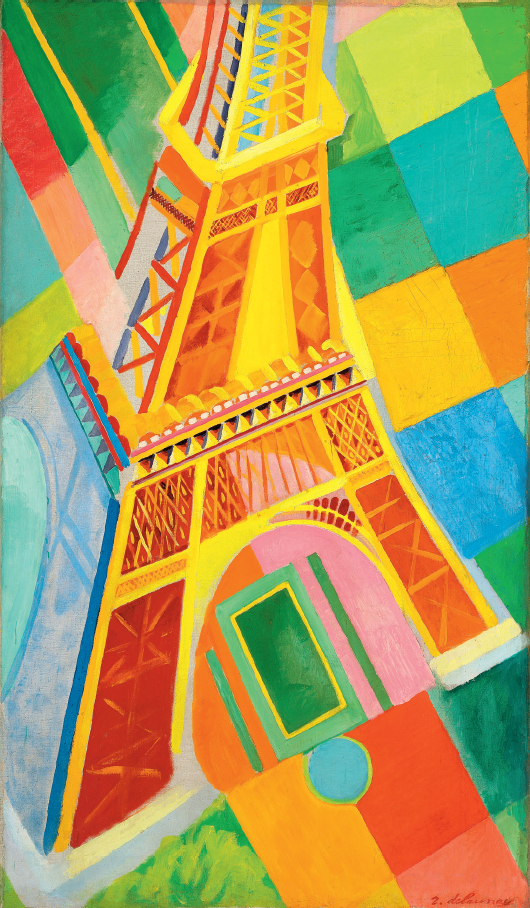Understanding World Societies:
Printed Page 874
Chapter Chronology
Modern Architecture, Art, and Music

Eiffel Tower, 1926
The works of the French artist Robert Delaunay (1885–1941) represent most of the major art styles of the early twentieth century, including modernism, abstraction, futurism, fauvism, cubism, and Orphism. His early renderings of the Eiffel Tower (1909–1912), the iconic symbol of urbanization, the machine age, and, as a radio tower, limitless communication, possess features drawn from several of these styles. His later paintings of the Eiffel Tower, such as the one shown here, draw on a much wider palette of brilliant colors, reflecting aspects of a style known as Orphism, with which he is most closely identified. (Eiffel Tower, 1926, oil on canvas by Robert Delaunay [1885–1941]/Private Collection/Photo © Christie’s Images/The Bridgeman Art Library)
Like scientists and intellectuals, creative artists rejected old forms and old values after the war. Modernism in architecture, art, and music meant constant experimentation and a search for new kinds of expression.
The United States pioneered in the new architecture. In the 1890s the Chicago School of architects, led by Louis H. Sullivan (1856–1924), used cheap steel, reinforced concrete, and electric elevators to build skyscrapers and office buildings lacking almost any exterior ornamentation. The buildings of Frank Lloyd Wright (1867–1959) were renowned for their sometimes-radical design, their creative use of wide varieties of materials, and their appearance of being part of the landscape.
In Europe architectural leadership centered in German-speaking countries. In 1919 Walter Gropius (1883–1969) merged the schools of fine and applied arts at Weimar into a single interdisciplinary school, the Bauhaus. Throughout the 1920s the Bauhaus, with its stress on functionalism and good design for everyday life, attracted enthusiastic students from all over the world.
Art increasingly took on a nonrepresentational, abstract character. New artistic styles grew out of a revolt against French impressionism, which was characterized by an overall feeling, or impression, of light falling on a real-life scene before the artist’s eyes, rather than an exact copy of objects. Though individualistic in their styles, “postimpressionists” and “expressionists” were united in their desire to depict unseen inner worlds of emotion and imagination.
In 1907 in Paris the famous Spanish painter Pablo Picasso (1881–1973), along with Georges Braque, Marcel Duchamp, and other artists, established cubism — an artistic approach concentrated on a complex geometry of zigzagging lines and sharply angled overlapping planes. Since the Renaissance, artists had represented objects from a single viewpoint and had created unified human forms. Cubism represented a radical new view of reality.
The ultimate stage in the development of abstract, nonrepresentational art occurred around 1910. Artists such as the Russian-born Wassily Kandinsky (1866–1944) turned away from nature completely.
Radicalization accelerated after World War I. The most notable new developments were New Objectivity, Dadaism, and surrealism. Paintings inspired by the New Objectivity were provocative, emotionally disturbing, and harshly satirical. Dadaism attacked all accepted standards of art and behavior, delighting in outrageous conduct. Surrealists painted fantastic worlds of wild dreams and complex symbols.
Developments in modern music were strikingly parallel to those in painting. Attracted by the emotional intensity of expressionism, composers depicted unseen inner worlds of emotion and imagination. Likewise, modernism in opera and ballet flourished. Led by Viennese composer Arnold Schönberg (SHUHN-buhrg) (1874–1951), some composers turned their backs on long-established musical conventions. As abstract painters arranged lines and color but did not draw identifiable objects, so modern composers arranged sounds without creating recognizable harmonies.
